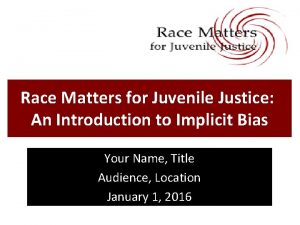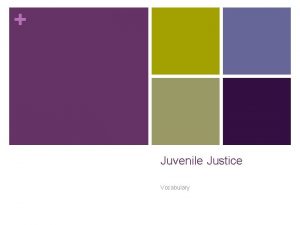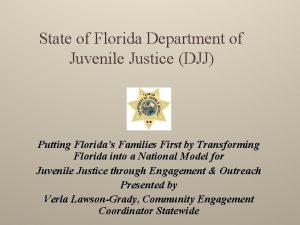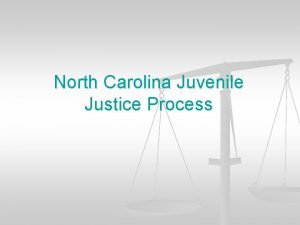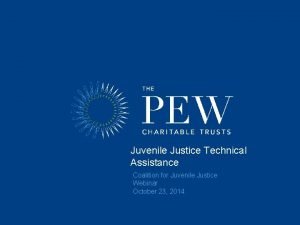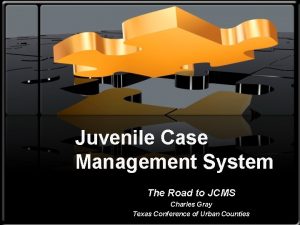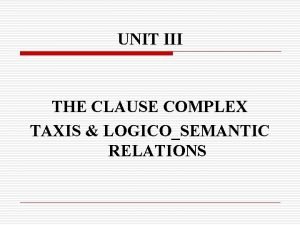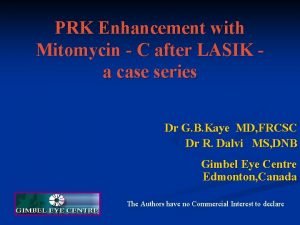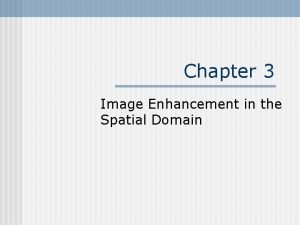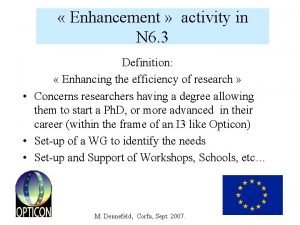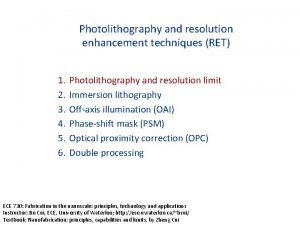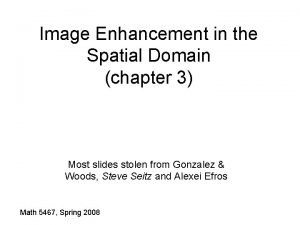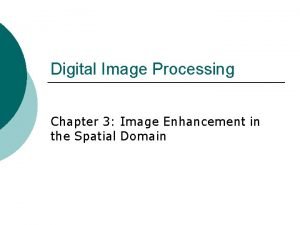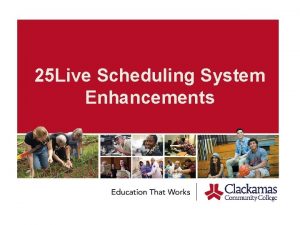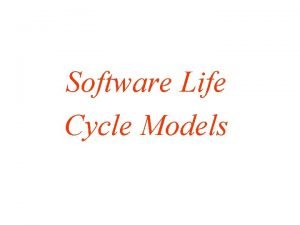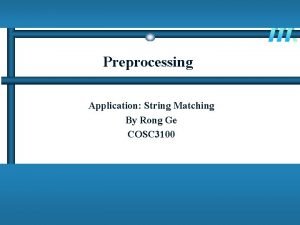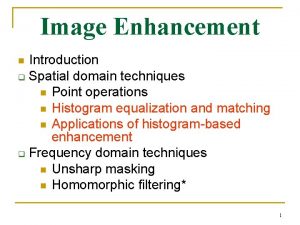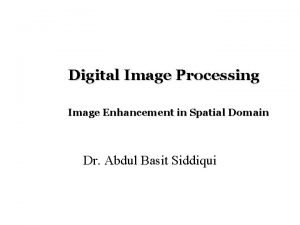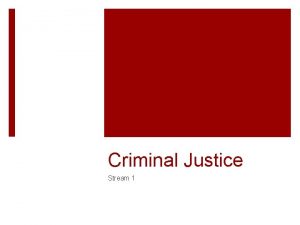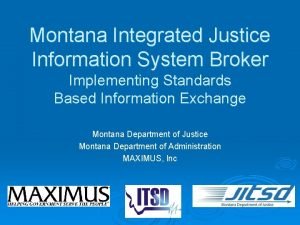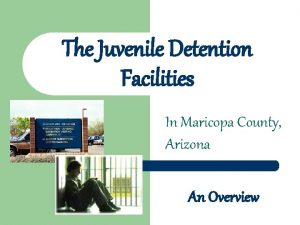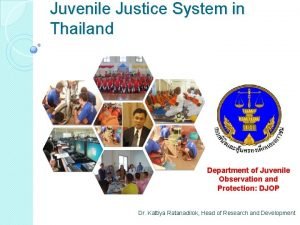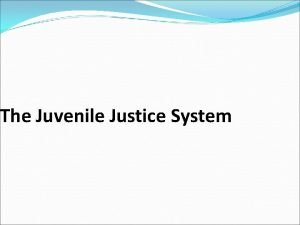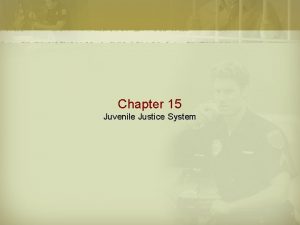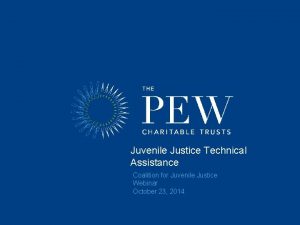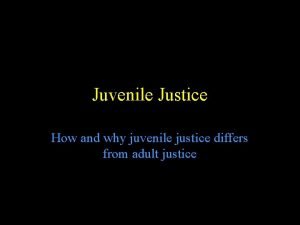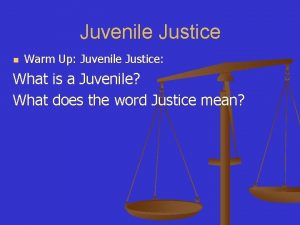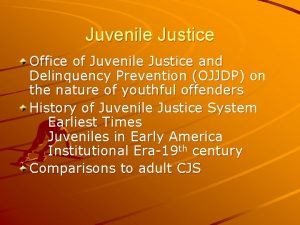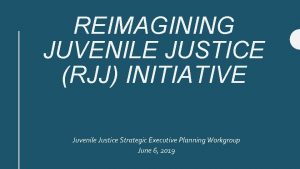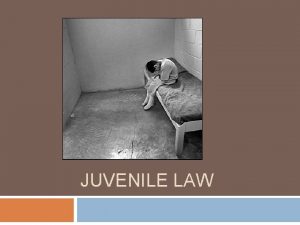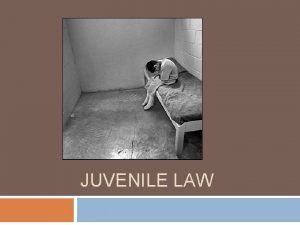Pennsylvanias Juvenile Justice System Enhancement Strategy Statement of














































































- Slides: 78

Pennsylvania’s Juvenile Justice System Enhancement Strategy Statement of Purpose We dedicate ourselves to working in partnership to enhance the capacity of Pennsylvania’s juvenile justice system to achieve its balanced and restorative justice mission by: • Employing evidence-based practices, with fidelity, at every stage of the juvenile justice process; • Collecting and analyzing the data necessary to measure the results of these efforts; and, with this knowledge, • Striving to continuously improve the quality of our decisions, services and programs.

Elements of Pennsylvania’s Juvenile Justice System Enhancement Strategy

How does our System Enhancement Strategy coincide with Balanced and Restorative Justice? Balanced and restorative justice represents the foundational principles upon which our juvenile justice system is built • Community protection • Accountability to victims and community • Competency development Our juvenile justice system enhancement strategy will enhance our collective capacity to achieve our balanced and restorative justice goals

Resources Available

Statewide Achievements • PA selected as a Mac. Arthur Foundation core state for juvenile justice reform in 2005 • In March 2006 we marked the 10 th anniversary of the enabling legislation that changed the purpose clause to reflect balanced and restorative justice principles. • Educational Aftercare and Reintegration Toolkit published in 2006

Statewide Achievements • Probation Case Management Essentials published in 2008 • Family Involvement in PA’s Juvenile Justice System published in 2009 • Guide to Developing Pre-Adjudication Diversion Policy and Practice in PA published in 2010

Statewide Achievements 2005 -2009 Outcome Measures • Completed supervision without a new offense: 85. 89% • Restitution paid in full: 85. 03% ($12, 591, 422) • Community service completion: 92. 73% (2, 741, 527 hrs. ) • % ordered to attend victim awareness curriculum and competency development programming have increased • % at case closing either employed or in an educational or vocational program: 80. 96%

How have we done long-term? • While our intermediate outcomes are good, what is the recidivism rate following case closure? • JCJC and the Pa. Council of Chief Juvenile Probation Officers have agreed on a measure of recidivism: Any misdemeanor or felony adjudication, or conviction, within two years after a case is closed.

What we do know about recidivism: (New offense while under supervision: 2005 -2009) 2005 = 12. 2% 2006 = 13. 2% 2007 = 14. 7% 2008 = 14. 9% 2009 = 15. 6% SOURCE: JCJC Statewide Outcome Measures

What’s our long-term rate? Any guesses… given the fact that on average 14% of the cases we close in any given year have committed an offense while under supervision?

We don’t know!!!!!! • There is no national juvenile offender recidivism rate. • PA had no established measure until now. • In 2005, three states reported an average 55% recidivism rate after 12 months based on a delinquent or criminal rearrest. • That same year eight states reported an average 33% recidivism rate based on a conviction or adjudication within 12 months. • Several other states reported an average 24% recidivism rate based on incarceration. SOURCE: Juvenile Offenders and Victims: 2006 National Report Office of Juvenile Justice and Delinquency Prevention U. S. Department of Justice

Has our system relied too long on quackery?

Correctional Quackery The use of treatment interventions that are based on neither: 1. existing knowledge of the causes of crime; nor 2. existing knowledge of what programs have been shown to change offender behavior. Latessa, Cullen and Gendreau, 2002

A true profession? To make our “business” of juvenile justice truly a profession, our practices must be based on research, training and expertise. We must take advantage of the research that tells us the empirically established, or known, predictors of recidivism - and the on-going research that tells us what works and what doesn’t.

Pre-Adjudication Diversion Models for Change • Mental Health/Juvenile Justice Joint Policy Statement • Diversion Subcommittee • Model Counties - (Allegheny – CIT; Lehigh – School Justice Panel; Chester – Intake Probation Diversion) • Pre-adjudication Diversion Principles and Guide Sustainability • Diversion Subcommittee of PCCD’s Juvenile Justice and Delinquency Prevention Committee (home) Next Steps • Funding and Implementation

Resources Available

Disproportionate Minority Contact (DMC) Federal Juvenile Justice and Delinquency Act PCCD’s DMC Subcommittee (home) • Youth and Law Enforcement Forums • Law Enforcement Curriculum and School Curriculum • Latino Needs Assessment Models for Change • Guidelines for Collecting and Recording Race and Ethnicity • Model Counties: Allegheny, Berks and Philadelphia • Law Enforcement Curriculum Key Next Steps • Evaluation and Dissemination Plan for Law Enforcement Curriculum • Statewide Assessment of DMC / Data Collection

Resources Available

Family Involvement • A goal of Mental Health / Juvenile Justice Joint Policy Statement • Focus Groups led to Family Involvement Monograph • Plenary Session during 2009 Pa. Conference on Juvenile • Chiefs’ Council creates Family Involvement Committee (home) • PCCD’s JJDPC expresses support for “sustained attention” to Family Involvement and requests long-term implementation plan

Family Involvement Models • Chester County Juvenile Justice Family Advocate • Philadelphia Parent Empowerment and Knowledge (PEAK) Peer Training • Philadelphia Family Advocacy Office in Family Court • Mercer County retreat for families to provide information on juvenile justice programs and individual support • Family Group Decision Making • Evidence-based family-centered interventions such as MST, FFT, and High-Fidelity Wraparound

Family Involvement Next Steps • Develop and Pilot Training Curriculum for System Professionals • Regional Forums • Develop and Disseminate Family Resource Guide • Identify additional written resources • Develop long-term Sustainability Plan for the JJDPC

Resources Available

Screening & Assessment Instruments • Detention Assessment Instrument • Massachusetts Youth Screening Instrument ~ Version 2 (MAYSI~2) • Youth Level of Service / Case Management Inventory (YLS/CMI)

Detention Assessment Instrument Detention admission decisions should be based on two reasons, related to risk: 1. The risk to abscond 2. The risk to recidivate The use of a detention assessment allows decisions to be made fairly, consistently and less subjectively Alternatives to detention Status of statewide implementation

Massachusetts Youth Screening Instrument ~Version 2 (MAYSI~2) Goal of MH/JJ Joint Policy Statement • Juvenile Detention Centers - 10 years experience • Technical assistance / training from NYSAP • “MAYSI-2 Pilot Site Reference Guide” • Hardware and software costs funded by PCCD • 24 juvenile probation departments participating • Monthly “User Group” conference calls

Massachusetts Youth Screening Instrument: Version 2 (MAYSI~2) • Self-report behavioral health questionnaire • 52 items in a yes/no response in electronic format • 10 to 15 minutes to administer • 5 th grade reading level • Does not require clinical expertise to administer or score • Capacity to collect data

Pennsylvania’s MAYSI~2 Data • Pa. data is relatively consistent with national norms • 68% of the youth scored in the Caution level • 23% of the youth scored in the Warning level • 15% of the youth scored at Critical Case Threshold level (which suggests that an immediate response occur) • Females scored at a rate more than two & half times than the rate for males at the Critical Case Threshold level

Legal Protections Goal of Mental Health / Juvenile Justice Joint Policy Statement • Act 109 of 2008 provides that no statements, admissions or confessions made by, or incriminating information obtained from, a child in the course of screening or assessment shall be admitted into evidence on the issue of whether the child committed a delinquent act, or on the issue of guilt in a criminal proceeding.

Resources Available

Evidence-Based Risk/Need Assessments • Improves decision making • Educates about delinquency risk factors • Determines level of risk to recidivate • Identifies and focuses attention on criminogenic needs • Matches proper services to needs, based on risk • Assists in determining appropriate levels of supervision • Establishes measurable case-specific goals • Allocates resources to achieve better outcomes for juveniles, families, victims and their communities • Ultimately assists in risk reduction = community protection

Key Concepts of a Risk/Need Model Criminogenic Risk - Factors within the individual or his/her environment associated with delinquent activity that impact the likelihood of re-offending. • Static Risk Factors - do not change Criminogenic Need - Factors that can be changed and, if changed, reduces the chances of future delinquent activity. • Dynamic Risk Factors - changeable, targets for services and interventions Responsivity - Factors within the individual or his/her environment that affect their response to interventions (strength and protective factors)

Youth Level of Service (YLS)

Youth Level of Service/Case Management Inventory (YLS/CMI) • The YLS/CMI is the youth version of the Level of Service Inventory – Revised (LSI-R). It is evidence-based with inter-rater reliability and predictive validity • Shown to assist in focused and goal directed, strength based case planning • Allows for professional override when appropriate • Valid for both boys and girls; not jurisdiction specific • YLS risk and need domains have been shown to be the strongest predictors of youth crime and potential for recidivism

Components of YLS/CMI Part I: Assessment of Risk and Needs Part II: Summary of Risk/Needs Part III: Assessment of Other Needs/ Special Considerations Part IV: Case Manager Assessment Part V: Contact Level Part VI: Case Management Plan

Criminogenic Needs • Prior and current offenses (anti-social history (static)) * • Attitudes/Orientation (anti-social thinking) * • Personality/Behavior (anti-social temperament)* • Peer relations (anti-social companions)* • Family circumstances* • Substance abuse • Education/Employment • Leisure/Recreation * Domains that research has shown to be the strongest predictors of potential for impact on risk reduction.

The top 4 + 1 Current and prior offenses Attitudes/Orientation Personality/Behavior Peer relations Family circumstances

Why target criminogenic needs? Research has shown that the risk of recidivism is greatly reduced (10 -30% on average) when attention is paid to criminogenic needs. SOURCE: D. A. Andrews, I. Zinger, R. D. Hoge, J. Bonta, P. Gendreau and F. T. Cullen, Does correctional treatment work? A clinically relevant and psychologically informed meta-analysis, Criminology, 28 (1990); Andrews (2007)

Resources Available

% Re-Offended Impact of Matching the Right Youth to the Right Services (Vieira et al. , 2009) Match based on # of Services Provided in Response to a Youths’ Risk/Need Factor

Service Delivery • When services (community or residential) are matched to youths’ crime-producing (criminogenic) needs…. the lower the chance of repeat offending • In other words, the right services for the right youth • Presently working on service matrices within probation departments and encouraging providers to do the same. • Base the matrix on the domains and the risk level within those domains • Importance of not mixing low risk youth with moderate and high risk youth in programming

Case Planning • Match services and target interventions to criminogenic needs • Needs are prioritized and addressed in a case plan • Strength and protective factors are taken into consideration • Victim and community needs are addressed in plan • Enhances ability to achieve BARJ goals • A case plan is the centerpiece of why an assessment is done. Focus on issues most likely to increase risk of re-offending.

Implementation in Pennsylvania • June 2008, Chiefs’ Council made commitment to use a Risk. Need Assessment and reviewed various instruments • Assistance from National Youth Screening and Assessment Project (NYSAP). Decision to use YLS/CMI • Implementation costs supported by $75, 000 grant from PCCD to Chiefs’ Council • Since 2009, twenty-six counties have been trained and have implemented the YLS and Case Plan. • Fourteen counties, to date, have committed to implementing YLS/CMI in 2011.

Implementation (continued) • Sustainability funding through the Needs Based Budget • The YLS is in the Pa. Juvenile Case Management System (JCMS) • Currently working on case plan for JCMS • Toolkit has been developed to assist with implementation • Three counties involved in YLS Research Project • Data and Outcomes will be tracked • Motivational Interviewing, Quality Assurance, Evidence-Based Probation Practices and Booster training are part of this process

Evidence-Based Practices (EBP) • “The objective, balanced and responsible use of current research and the best available data to guide policy and practice decisions, such that outcomes for consumers are improved. ” National Institute of Corrections • Based on the notion that our practices and interventions are most effective when they reduce offender risk and subsequent recidivism, and therefore make a long-term contribution to public safety.

Evidence-Based Practices (EBP) • EBP moves us away from what feels good, customs, intuition and what we think works (correctional quackery) • EBP implies that the practice is research-based, has definable outcomes and is measurable. • EBP is not a program, but a more professional way of doing business

What is EBP? • Better identification of offender risk, needs and strengths • Better case planning • Targeted interventions, strategies and practices to address and reduce criminogenic risk factors among offenders BOTTOM LINE: Reduction of risk = reduction in recidivism

8 Evidence-Based Principles of Effective Intervention 1. 2. 3. 4. 5. 6. 7. 8. Assess risk and needs Target interventions Enhance intrinsic motivation Increase positive reinforcement Skill train with directed practice using cognitive behavioral treatment methods Engage ongoing support in natural communities Measure relevant processes and practices Provide measurement feedback SOURCE: Implementing Evidence-Based Practices In Community Corrections: The Principles of Effective Intervention, National Institute of Corrections

What does an Evidence-Based Probation Department look like? • While keeping Balanced and Restorative Justice in the forefront, our goal needs to be risk reduction • Routine identification of risk levels and areas of criminogenic risk, needs and strengths. • The development of SMART case plans based on risk and need • SMART = Specific, Measurable, Attainable, Relevant and Timebound • Supervision levels tied to the risk to re-offend • Minimal supervision of low-risk offenders

What does an Evidence-Based Probation Department look like? • Not mixing low and high risk offenders in groups, work crews, waiting rooms, etc. • Developing professional alliances with offenders and their families • Creating the climate for change with Motivational Interviewing • Skill training with offenders • Utilization of cognitive behavioral treatment methods • Use of graduated responses for probation violations

What does an Evidence-Based Probation Department look like? • Increasing positive reinforcement • Catch them doing something good! • Engaging and strengthening families • Tracking and measuring change more effectively • Tracking placement outcomes and requiring providers to deliver interventions that address the criminogenic risk and needs we identify

Aftercare Initiative Activities • Joint Policy Statement on Aftercare • State Level Workgroups - Courts, Probation, Children & Youth, Education • County Level Work – Five Model Counties Allegheny – Education Reintegration Cambria – Workforce Development Lycoming – Parental Involvement/Service Expansion Philadelphia – Reintegration System Reform York – Intensive and Triage Aftercare Model Implementation

Aftercare Initiative Activities • The “All Sites” Group • Aftercare Specialists • 67 Counties Involved in Aftercare Enhancement Activities • Educational Aftercare & Reintegration Toolkit • Probation Case Management Essentials for Youth in Placement • Placement Referral Checklist • Pennsylvania Academic, Career & Technical Training Alliance (PACTT)

Aftercare Going Forward…… • Ongoing attention to our “lessons learned” • Data collection to determine systemic change…and continued focus on key issues! • Work with providers to: • Expand PACTT Alliance participation • Alignment with risk factor identification and case planning • Chief/Provider Forum is venue for on-going discussion • PCCD support of Aftercare Specialist positions

Resources Available

What’s the Difference? Programs can be placed along a continuum of “proof” of effectiveness ü Best Practices Not much “We’ve done it and we like it” ü Research-based “This program is based on sound theory informed by research” confidence ü Promising Approaches “We really think this will work… but we need time to prove it” Very much confidence ü Evidence-based “This program has been rigorously evaluated and shown to work” How confident are we that this program is a good use of resources AND improves outcomes for children and families?

High Quality Services and Programs Resource Center for Evidence-based Prevention and Intervention Programs and Practices • Evidence-based Prevention and Intervention Support Center (EPISCenter) • National Center for Juvenile Justice “Quality Improvement Initiative” • “Program and Practice Effectiveness Toolkit”

Resource Center for Evidence-based Prevention and Intervention Programs and Practices MISSION: To support the proliferation of quality prevention and intervention programs aimed at promoting positive youth development and preventing violence, delinquency, substance abuse and other problem behaviors. Funded by PCCD and DPW’s Office of Children, Youth and Families.

Resource Center for Evidence-based Prevention and Intervention Programs and Practices Three Core Components • Development of local community coalitions to support research-based program selection and implementation (Communities That Care) • Funding and technical assistance/training to support a finite list of programs eligible for funding • Support to improve the quality of local delinquency interventions for juveniles

EPISCenter The EPISCenter supports the dissemination, quality implementation, sustainability, and impact assessment of a menu of proven-effective prevention and intervention programs, and conducts original translational research to advance the science and practice of evidence-based prevention. Evidence-based Programs Supported 1. 2. 3. 4. 5. 6. Big Brother Big Sisters 7. Functional Family Therapy Life. Skills Training Program 8. Multidimensional 9. Treatment Foster Care Multisystemic Therapy Olweus Bullying Prevention 10. Program Project Toward No Drug Abuse Promoting Alternative Thinking Strategies Strengthening Families 10 -14 The Incredible Years

EPISCenter Goals • Serve as a resource to the field related to the implementation of evidence-based programs • Promote the proliferation of EBPs by educating practitioners and providers about the practical and economic benefits of implementing and utilizing EBPs. • Work with program developers to establish in-state training and technical assistance capacity.

EPISCenter Next Steps • Ongoing Technical Assistance to Evidence-Based Programs • Ongoing Technical Assistance to CTC sites • Coordination of CTC with other community prevention coalitions • Web-based data reporting system for all EBPs • “Return on Investment” Study www. episcenter. psu. edu

Quality Improvement Initiative (Qii) The Qii is designed to enhance the quality of interventions targeting delinquency risk factors by offering both a strategy for assessing how interventions align with best practices, and support for providers to incorporate best practices into interventions. • Research-based interventions to address needs shown to contribute to delinquency; • Clearly defined anticipated outcomes associated with intervention; • Using information from valid assessments to identify appropriate interventions; • Implementing interventions with fidelity; and • Monitoring the impact of interventions on juveniles by collecting data on anticipated outcomes.

Qii Goals • Support local homegrown/promising intervention programs in achieving the juvenile justice system goals of community protection, offender accountability and competency development • Increase the inclusion of recognized best practice approaches • Support programs in demonstrating their effectiveness BOTTOM LINE: Evidence-based Programs are not the only game in town.

Qii Next Steps • About two dozen providers are participating in process • NCJJ has slots open for this year’s class • Plan to incorporate Qii process for the diversion programs beginning July 1, 2011. Contact Teri Deal at deal@ncjj. org for more information.

Data Analysis and Research “He who ceases to try and do better ceases to do well. ” Oliver Cromwell Our System Enhancement Strategy is: • a commitment to a systemic culture of continuous quality improvement • an effort to build on our strengths and improve our future service delivery • BUT not meant to point fingers or assess blame • Rather it is a collaborative effort that involves strategic planning and goal assessment to continually improve the processes and service delivery of PA’s JJS.

Data Analysis and Research • Using statistical tools we need to: • develop an understanding of our system processes • Identify and define measures of success • Identify areas that need improvement • Develop change strategies to improve identified areas • Establish the means to scientifically measure outcomes and analyze change strategy • Revise change strategy as needed with an eye towards improving the process

Data Analysis and Research Examples of data analysis and research projects in PA: • JCJC Outcome Measures at case closing • BARJ research project • YLS research project • Disproportionate Minority Contact statewide assessment • Qii • County-initiated data collection and analysis

Data Analysis and Research Recidivism – • The Juvenile Justice Advisory Committee, comprised of representatives from the Chiefs’ Council and JCJC staff, has defined recidivism as an adjudication of delinquency or a criminal court conviction for a misdemeanor or felony offense within two years after release from juvenile court supervision. • CJJTR is preparing to establish a benchmark for recidivism involving juveniles released from probation supervision during 2007.

Data Analysis and Research • PA is ripe with data and processes that warrant analysis. • A critical component of our strategy is the collection and analysis of quality data. • The Chiefs’ Council and JCJC have initiated steps to ensure the accuracy of data. • Data collection, analysis, and research are the tools that will guide us toward our goal of quality service delivery.

What’s Next? ● Strategic Planning ● Broader Involvement ● Work Plans ● Communications Strategy ● Written Materials ● Training ● Data Analysis ● Higher Education

Opportunities for Involvement Screening and Assessment • MAYSI-2 • Detention Assessment • Youth Level of Service / Case Management Inventory ► Diversion Beth Fritz Rick Steele ► Alternatives to Detention ► Case Planning elizabethfritz@lehighcounty. org ricsteele@state. pa. us

Opportunities for Involvement Quality Supervision and Practices • • Family Involvement ● Aftercare Motivational Interviewing ● PACTT Alliance Graduated Responses ● DMC Evidence-Based Probation Practices Bob Williams rwilliams@countyofberks. com

Opportunities for Involvement Service Providers • Evidence-Based Programs • Quality Improvement Initiative (Qii) • Curricula That Targets Identified Needs Mike Pennington Keith Snyder mpenningto@state. pa. us ksnyder@state. pa. us

Opportunities for Involvement Data Analysis and Research • • • Quality Data Identify Measures of Success Data Analysis Data Informs Policy and Programs Research Bob Stanzione rjstanzione@co. bucks. pa. us

Additional Information Beth Fritz elizabethfritz@lehighcounty. org Mike Pennington mpenningto@state. pa. us Keith Snyder ksnyder@state. pa. us Bob Stanzione rjstanzione@co. bucks. pa. us Rick Steele ricsteele@state. pa. us Bob Williams rwilliams@countyofberks. com www. jcjc. state. pa. us

Is it worth it? 1772

If we could have reduced the recidivism rate for children under our supervision by 2 percentage points in each of the past five years, that would have translated into 1772 fewer victims.

Is it worth it? 1772
 Georgia juvenile justice system
Georgia juvenile justice system Ra no. 9344
Ra no. 9344 Juvenile justice system in georgia
Juvenile justice system in georgia Minnesota juvenile justice system
Minnesota juvenile justice system Race matters for juvenile justice
Race matters for juvenile justice Criminal law and juvenile justice unit 2
Criminal law and juvenile justice unit 2 Juvenile delinquency vocabulary words
Juvenile delinquency vocabulary words State of florida department of juvenile justice
State of florida department of juvenile justice Juvenile justice alternative education program
Juvenile justice alternative education program Juvenile justice act 2000
Juvenile justice act 2000 Undisciplined juvenile petition nc
Undisciplined juvenile petition nc Coalition for juvenile justice
Coalition for juvenile justice Juvenile case management system
Juvenile case management system Complex sentence
Complex sentence Family enhancement center
Family enhancement center Scodix ultra 101 price
Scodix ultra 101 price Mitomycin c prk
Mitomycin c prk Nmos inverter with resistive load
Nmos inverter with resistive load Image enhancement in night vision technology
Image enhancement in night vision technology Objective of image enhancement
Objective of image enhancement Inverse log transformation in image processing
Inverse log transformation in image processing Mre
Mre Credit enhancement
Credit enhancement Coalition for physician enhancement
Coalition for physician enhancement Integrity enhancement features of sql
Integrity enhancement features of sql Image enhancement in spatial domain
Image enhancement in spatial domain What is the proper procedure for applying one color monomer
What is the proper procedure for applying one color monomer Penapis
Penapis Enhancement mosfet
Enhancement mosfet Fet
Fet Academic enhancement
Academic enhancement Enhancement activity
Enhancement activity Combining spatial enhancement methods
Combining spatial enhancement methods Point processing
Point processing Enhancement using arithmetic/logic operations
Enhancement using arithmetic/logic operations 7 step sourcing methodology
7 step sourcing methodology Resolution enhancement techniques
Resolution enhancement techniques What is enhancement in the spatial domain?
What is enhancement in the spatial domain? Human performance enhancement
Human performance enhancement Iii image inhancement
Iii image inhancement Combining spatial enhancement methods
Combining spatial enhancement methods Live enhancement
Live enhancement Inerativ
Inerativ Ethical hacking seminar
Ethical hacking seminar Contrast enhancement
Contrast enhancement Input enhancement in string matching
Input enhancement in string matching Centre for learning enhancement and research
Centre for learning enhancement and research Idl medical ent
Idl medical ent Revenue enhancement synergy
Revenue enhancement synergy Listening and communication enhancement
Listening and communication enhancement Edge enhancement
Edge enhancement Image enhancement in spatial domain
Image enhancement in spatial domain Image enhancement in spatial domain
Image enhancement in spatial domain Road mapping in digital subtraction angiography
Road mapping in digital subtraction angiography Image enhancement in spatial domain
Image enhancement in spatial domain Gonzalez
Gonzalez Graduate enhancement training sarawak
Graduate enhancement training sarawak Environmental enhancement and mitigation program
Environmental enhancement and mitigation program 4 pillars of criminal justice system
4 pillars of criminal justice system Supreme court justice system
Supreme court justice system Arizona criminal justice information system
Arizona criminal justice information system Responsibilities of saps in the criminal justice system
Responsibilities of saps in the criminal justice system Katarungang tagapagkasundo
Katarungang tagapagkasundo What are the branches of criminal justice system
What are the branches of criminal justice system Integrated justice system
Integrated justice system The american system of criminal justice 16th edition
The american system of criminal justice 16th edition Notas rojas
Notas rojas Juvenile act
Juvenile act Juvenile court durango
Juvenile court durango Pornography laws connecticut
Pornography laws connecticut Role of special juvenile police unit
Role of special juvenile police unit Polyarticular arthritis
Polyarticular arthritis Missouri juvenile officer performance standards
Missouri juvenile officer performance standards Department of juvenile observation and protection
Department of juvenile observation and protection Jda canada
Jda canada Juvenile law definition
Juvenile law definition Newspaper article on juvenile delinquency
Newspaper article on juvenile delinquency Juvenile delinquents act canada
Juvenile delinquents act canada Fran carino juvenile law website
Fran carino juvenile law website




